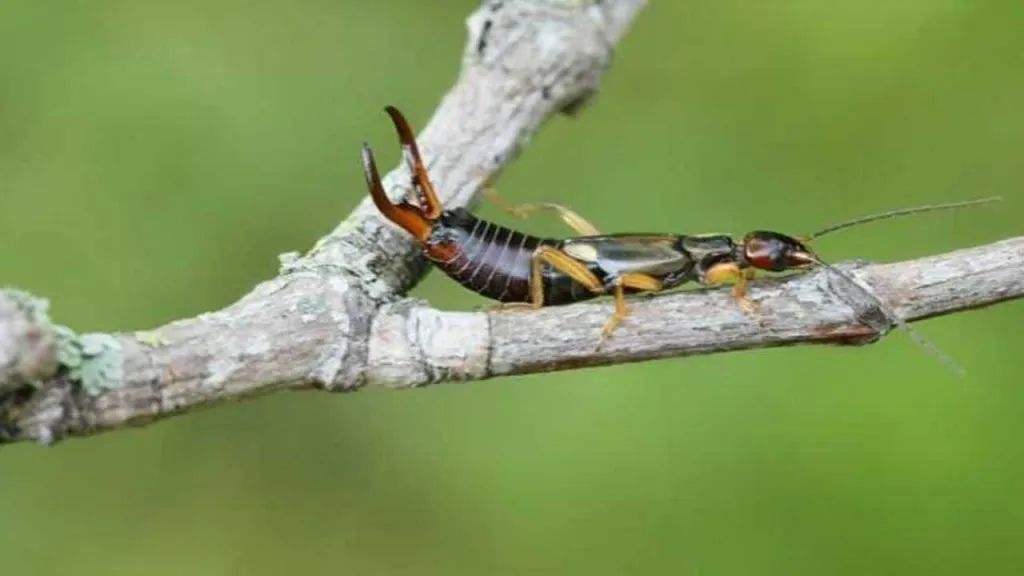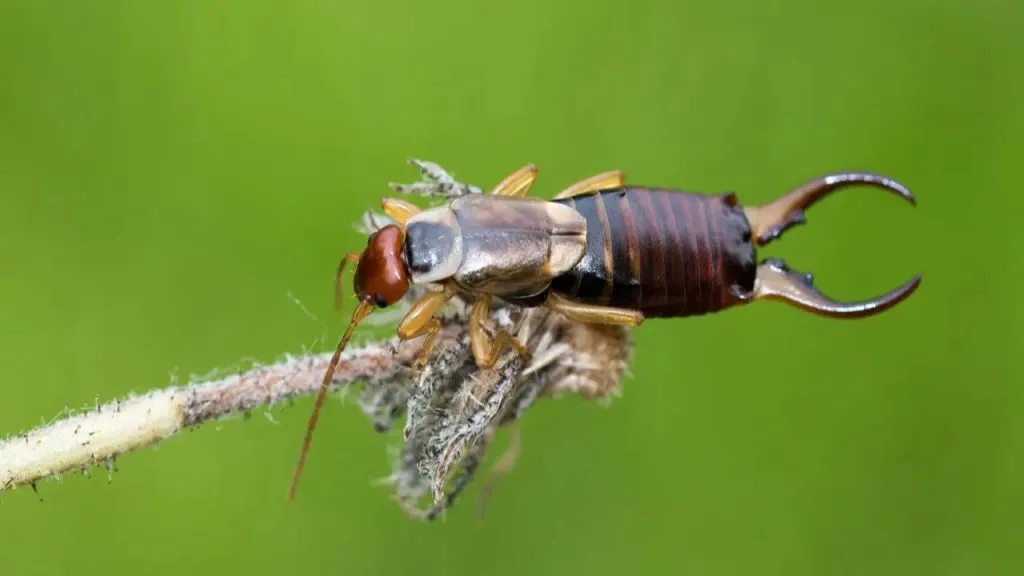As an Amazon Associate I earn from qualifying purchases.
Earwigs may look a bit strange with their pincer-like features, but they’re fascinating creatures that catch our attention.
They come out at night, and guess what? They’re not picky eaters – they’ll happily munch on anything that’s not alive, be it other bugs or even your clothes!
But earwigs aren’t just annoying pests. They help keep our environment in check by eating other bugs.
In this article, we’ll take a closer look at the different types of earwigs, what they like to eat all year round, where they prefer to hang out, how they hunt, and ways to keep them from becoming too bothersome.
We’ll also check out the challenges they face from other creatures in the wild. So let’s get started and learn more!
Types of Earwigs
1. European Earwig (Forficula auricularia)
The European Earwig, scientifically known as Forficula auricularia, is a prevalent type of earwig that has a particular fondness for a vegetarian diet.
These earwigs delight in indulging themselves in a feast of soft leaves, delicate petals, and ripe fruits.
They particularly savor tender greenery, especially during the night when the atmosphere is rich with moisture.
While they play a beneficial role in managing certain garden pests, it’s worth noting that they can sometimes turn into nibblers, especially targeting young seedlings and fragile blooms.
2. Ring-Legged Earwig
The Ring-Legged Earwig, also known as Euborellia annulipes, is a type of earwig without wings commonly seen in the southern United States.
They typically munch on leaves and rotting plant matter.
However, they’re not afraid to munch on insects now and then, showing they can eat both plants and animals when the chance arises.
3. Anisolabididae family
Anisolabididae family is a group of formidable hunters that actively track down and hunt various insects, such as aphids, mites, and even smaller earwigs.
Their strong pincers play a crucial role in overpowering their prey, making them highly effective predators within the garden ecosystem.
4. Labiduridae Family
In warmer regions, you’ll come across these stretched-out earwigs, which are adept hunters.
They employ their lengthy legs and pincers to nab insect prey, playing a crucial role in keeping pest populations in check within their habitats.
5. Spongiphoridae Family
These earwigs are primarily scavengers, foraging for decaying organic matter, fallen fruits, and deceased insects.
Their diet serves a vital purpose in breaking down organic material, replenishing nutrients in the soil, and promoting overall soil health.
Now that we know there are many types of earwigs, let’s explore what they eat to stay well-fed all year.
What do Earwigs Eat Year-Round?

1. Spring
In spring, earwigs often enjoy feasting on tender leaves and the delicate petals of flowers.
They actively search for and consume insect eggs during this season, playing a role in garden pest control.
Additionally, the presence of decaying plant matter in spring ensures a steady and reliable food source for these opportunistic insects.
2. Summer
In the summertime, earwigs show off their hunting skills by going after tiny insects like aphids and mites, which are plentiful.
They mainly eat plants that are not doing well anymore, spoiled fruits, and wood that’s starting to break down.
As the weather gets warmer, earwigs get braver with their food choices and enjoy eating ripe fruits like berries, strawberries, and peaches.
They might also nibble on vegetables such as lettuce, tomatoes, and the silk on corn.
3. Autumn
As nature starts to slow down, earwigs shift their focus to decaying stuff.
They happily eat fallen leaves, compost, and any soft fruits left behind.
While looking for food, earwigs might dig in the soil and under logs to find insect larvae and pupae.
As plants break down in the fall, earwigs keep eating decomposed plant bits, making sure they have enough food.
4. Winter
When it gets colder, earwigs get slower and use the energy they saved up.
They find cozy spots underground or in damp places to sleep through the coldest months, which is called hibernating.
During this time, they eat very little, mostly finding tiny bits of leftover plant stuff in their hiding spots.
Now that we understand what earwigs like to eat, let’s talk about the places they live and how they find food in their habitats.
Habitat of Earwigs
Earwigs are bugs that can live almost anywhere in the world.
They like gardens and flower beds where there are lots of plants and hiding spots.
They also enjoy places with damp soil, like mulch beds and areas close to water.
During the day, they hide under rocks, logs, or debris.
Earwigs aren’t picky; they can even be found in cities and towns, especially near gardens.
They rest in dark places like garden structures or fences when the sun is out.
Although they can live in different climates, earwigs prefer warmer areas.
Knowing where earwigs like to be helps us manage them better, keeping them away from places we don’t want them to be.
How do Earwigs Hunt Their Food?
Earwigs are like little food detectives, and they’ve got some cool tools to help them out.
Their standout tool is their strong pincers, kind of like tiny grabbers, officially called cerci.
These help earwigs grab and handle smaller insects and soft prey.
But that’s not all – earwigs also have great antennae for sniffing out smells and tiny hairs on their bodies that feel movement.
These features are useful when they’re looking for food in dark and damp places.
They usually do their food-finding mission in the dark, sneaking up on unsuspecting prey and surprising them.
Earwigs have different tricks up their sleeves for catching food.
They’re like stealthy hunters, patiently waiting in hidden spots like cracks or under leaves.
When other insects come close, earwigs quickly use their strong grabbers to make sure the prey can’t escape.
Apart from being good at ambushing, earwigs also act like little scavengers when they’re searching for food.
Sometimes, while looking for old stuff to munch on, they might find baby insects or slower adults and grab a quick protein snack.
If things get crowded or there isn’t much food around, earwigs might even eat smaller earwigs of their kind – a bit like bug cannibalism!
But it’s important to know that, even though they’re good at catching their food, earwigs play a big role in keeping things clean.
They help break down old plant stuff, keeping the environment healthy and balanced.
After looking into how good earwigs are at hunting, it’s important to think about how they might affect our environment and find ways to deal with them.

Eliminating Earwigs From Your Surroundings
If you want fewer earwigs around, here are some simple things you can do:
1. Clear Hiding Spots: Earwigs like cozy hiding places, so start by cleaning up your outdoor areas.
Get rid of debris, piles of leaves, and rocks where they might hide and lay eggs.
2. Adjust Garden Conditions: Make your garden less inviting for earwigs by reducing moisture.
Too much dampness attracts these bugs. Use a drip irrigation system to keep the soil dry, and don’t overwater your plants.
3. Bring in Natural Predators: Invite natural enemies of earwigs, like birds and helpful insects, into your garden.
They can help control the earwig population without using chemicals.
4. Diatomaceous Earth: Sprinkle food-grade diatomaceous earth where you see earwigs.
It’s safe for people and pets but scratches the outside of insects, like earwigs, making it hard for them to stay hydrated.
5. Simple Traps: Create traps using rolled-up newspapers or cardboard tubes.
Put these traps where you often find earwigs. Check and replace them regularly.
6. Essential Oils: Some oils like citrus or peppermint can keep earwigs away.
Mix a few drops with water and spray it where you see earwigs.
7. Commercial Insecticides: If the problem is big, you can use insecticides made for earwigs.
Follow the instructions carefully and think about how it might affect the environment.
Remember, using a mix of these methods is often the best way to control earwigs without hurting the environment.
As we finish talking about how to deal with earwigs, let’s take a look at the way things naturally work and check out the animals that help control the number of earwigs.
Predators of Earwigs
1. Predators with Backbones:
1.1 Birds: Many types of birds, like robins, blackbirds, starlings, sparrows, and even chickens and ducks, find earwigs to be a tasty snack.
Their sharp eyesight and quick movements make them skilled at catching these fast-moving insects.
1.2 Mammals: Animals that eat insects, such as shrews, moles, hedgehogs, and bats, consider earwigs a part of their menu.
These small mammals have a strong sense of smell, helping them easily find earwigs hiding in the bushes.
1.3 Amphibians: Creatures like frogs, toads, and salamanders are natural bug hunters, and earwigs often end up as a meal for them due to their sticky tongues and swift reflexes.
2. Critters without Backbones on the Hunt:
2.1 Spiders: Plenty of spider types, especially ground and wolf spiders, are quick to catch earwigs in their webs or during nighttime chases.
They don’t mind the earwigs’ pincers and use their agility and venom to beat them.
2.2 Centipedes: These crawly creatures take the chance to feast on earwigs they come across.
With lots of legs and a venomous bite, they make tough opponents even for the bigger earwigs.
2.3 Assassin Bugs: Aptly named, these bugs target various insects, including earwigs.
They inject venom that paralyzes their prey before slurping up their insides.
2.4 Parasitic Flies: Tachinid flies lay their eggs on earwigs.
The hatching larvae then dig into the host, munching on its insides and eventually causing its demise.
It’s a gruesome but effective way to keep earwig numbers in check.
3. Other Dangers:
3.1 Cannibalism: When it gets crowded or there’s not enough food, earwigs may start eating each other, especially the smaller ones of their kind.
3.2 Natural Challenges: Cold weather, lack of rain, and floods can be tough on earwigs.
These environmental factors make it harder for them to find food and have babies, affecting their overall numbers.
Conclusion
Earwigs have interesting roles in ecosystems worldwide, thanks to their varied diets and adaptable ways of living.
It’s crucial to know what they like, where they live, and who their natural enemies are for a peaceful coexistence with these nighttime insects.
With smart pest control methods, we can find a balance that keeps both earwigs and their environments in good shape.
FAQ’s:
Earwigs are drawn to places with moisture and shelter.
They love hiding in dark, damp areas like mulch beds, under rocks, or in piles of leaves.
Gardens with lots of plants and hiding spots are also quite attractive to them.
Earwigs lay their eggs in small burrows or nests in the soil.
They prefer laying eggs in warm, hidden places, often close to a food source.
Mulch beds and garden areas with decaying plant matter are common spots for earwig egg-laying.
The lifespan of an earwig varies, but on average, it’s about a year.
They go through different stages, starting as eggs and then developing into nymphs before becoming adults.
During their lifetime, earwigs molt several times, shedding their exoskeleton as they grow.
Amazon and the Amazon logo are trademarks of Amazon.com, Inc, or its affiliates.

